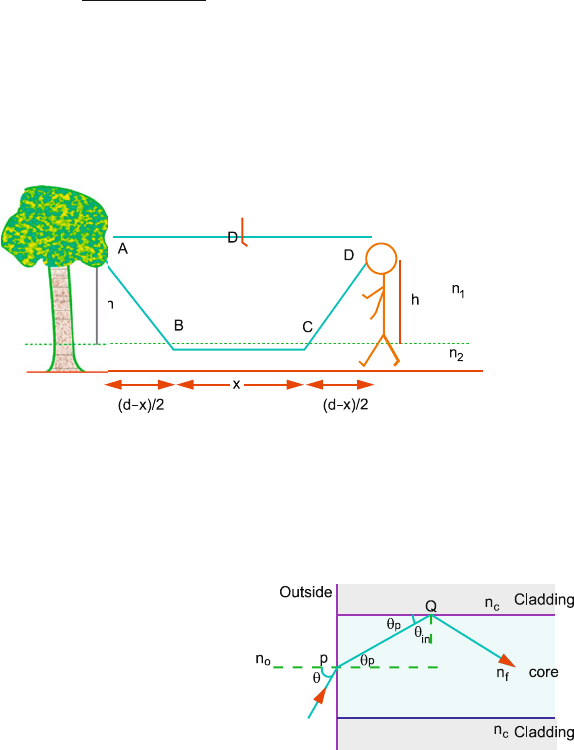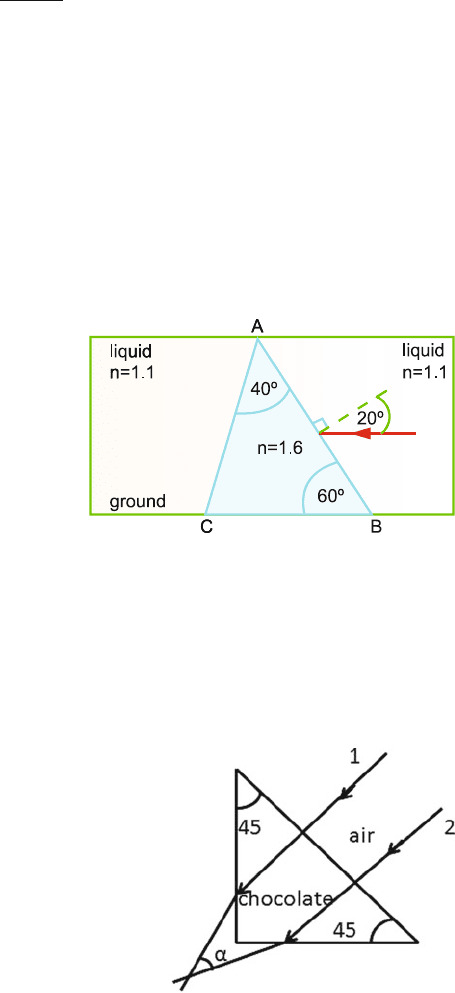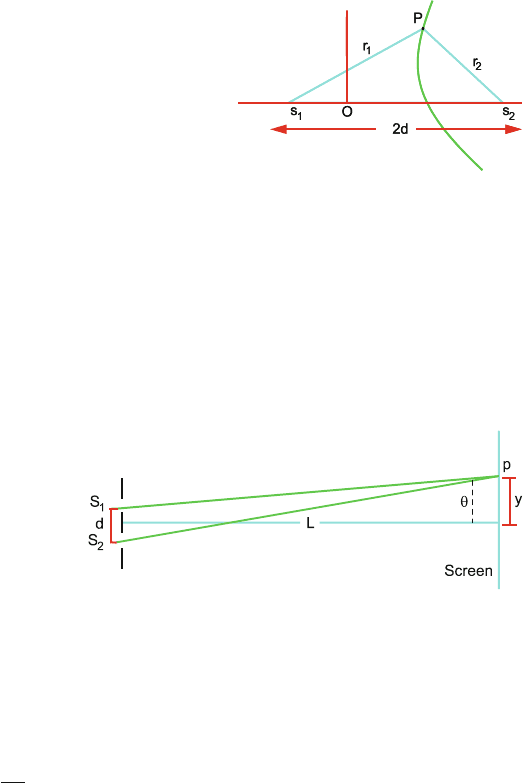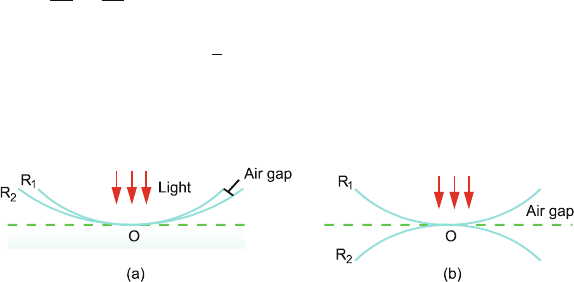Kamal A.A. 1000 Solved Problems in Classical Physics: An Exercise Book
Подождите немного. Документ загружается.


710 15 Optics
Since both m and p are integers, d/a must be in the ratio of two integers. Thus if
order 3 is missing then d/a = 3. Other interference fringes which are missing are
6, 9, ....
If the ratio d/a is not exactly equal to the ratio of two integers, then the intensity
of a particular order will not be zero but would be quite small.
Grating: Total number of lines (N) on the grating
N = N
W (15.38)
where N
is the number of lines per unit length and W is the grating width.
Resolving Power (R.P)
R = λ/dλ = Nm (15.39)
Dispersive Power of a Prism (D)
D =
dθ
dλ
=
dμ
μ − 1
(15.40)
Resolving power (R) for a prism of baselength B is given by
R =
λ
dλ
= B
dμ
dλ
(15.41)
where dμ/dλ is the variation of refractive index of the prism with wavelength, λ is
the mean wavelength and dλ is the difference in wavelengths to be resolved.
Diffraction from a Disc of Radius a
I = I
0
2J
1
(ρ)
ρ
2
(15.42)
where ρ = 2π
a
λ
sin θ and J
1
(ρ) is the Bessel function of the first kind.
Rayleigh’s Criterion
The minimum angular resolution of a telescope of diameter D is
θ = 1.22
λ
D
(15.43)
where D is the diameter of the telescope.

15.1 Basic Concepts and Formulae 711
Zone Plate
1
a
+
1
b
=
nλ
r
2
n
=
1
f
n
(15.44)
where a and b are the distances of the object and image from the zone plate, r
n
is
the radius of the nth zone and f the focal distance.
Polarization
Let the x- and y-components of the electric vector be given by
E
x
= a
1
sin ωt (15.45)
E
y
= a
2
sin(ωt +δ) (15.46)
E
2
x
a
2
1
+
E
2
y
a
2
2
− 2
E
x
E
y
a
1
a
2
cos δ = sin
2
δ (15.47)
(i) Plane-polarized (linearly polarized) light:
If δ = 2nπ where n = 0, 1, 2,... for which
E
y
=
a
1
a
2
E
x
(15.48)
or δ = (2n + 1)π, for which
E
y
=−
a
1
a
2
E
x
(15.49)
In either case the electric field oscillates on a straight line.
(ii) Elliptically polarized light:
If δ = (n + ½)π , where n = 0, 1, 2, ...and a
1
= a
2
E
2
x
a
2
1
+
E
2
y
a
2
2
= 1 (15.50)
If δ = π/2, 5π/2, 9π/2,... the tip of the electric vector rotates clockwise for
an observer towards whom light approaches, and the light is said to be left-handed
elliptically polarized.
If δ = 3π/2, 7π/2, 11π/2,... the ellipse is described in the counterclockwise
direction and the light is said to be right-handed elliptically polarized.
(iii) Circularly polarized light
If δ = (n + ½)π where n = 0, 1, 2,... and a
1
= a
2
= a
E
2
x
+ E
2
y
= a
2
(15.51)
Right-handed and left-handed circularly polarized light are described as in case (ii).
712 15 Optics
(iv) Unpolarized light:
If the phase difference δ is random between two linearly polarized waves at
right angles to each other, light is said to be unpolarized.
Malus’ Law
Consider two polarizing sheets P
1
and P
2
parallel to each other. Let the polarized
light of intensity I
m
from P
1
be incident on P
2
whose polarizing axis is oriented at
angle θ with that of P
1
. Then the transmitted intensity I from P
2
is given by
I = I
m
cos
2
θ (Malus’ law) (15.52)
Brewster’s Law
When an unpolarized light beam is incident on a dielectric surface then for a partic-
ular angle of incidence, called polarizing angle θ
p
, the reflected light is completely
plane polarized with its plane of vibration at right angles to the plane of incidence
(σ -component).
In this situation the reflected light and the refracted light beams are at right angles
tan θ
p
= n = n
2
/n
1
(Brewster’s law) (15.53)
where n is the refractive index of medium 2 with respect to medium 1.
At the polarizing angle the π-component of the beam (plane of vibration parallel
to the incident plane) is entirely refracted with an admixture of σ -component.
Brewster windows are used in laser technology to produce plane polarized light.
Birefringence: Optically isotropic substances exhibit optical properties such as
refractive indices independent of the direction of propagation of the electromag-
netic wave and the state of polarization of the wave. However, there are crystalline
solids such as calcite and quartz which exhibit optically anisotropic properties. Such
substances are called birefringent. In this case there are two refractive indices. If the
polarization is parallel to the optic axis, light will travel with one velocity, if the
polarization is perpendicular to the axis, light will travel with a different velocity.
Let a linearly polarized light be incident at the polarizing angle θ with the optical
axis. The polarization can be resolved into x- and y-components. Since the x- and
y-components travel with different speeds, their phases change at a different rate as
light travels down the material.
Full Wave Plate, Half-Wave Plate and Quarter Wave Plate
Full wave plate is the one in which the vibrations of two components which were in
phase initially remain in phase after light emerges from a thickness t of the material:
(n
slow
− n
fast
)t = mλ, m = 1, 2, 3 ... (15.54)
where λ is the wavelength in vacuum.

15.2 Problems 713
For half-wave plate
(n
slow
− n
fast
)t = (2m + 1)λ/2 (15.55)
This implies that if two components enter the slab in phase, they emerge from the
slab 180
◦
out of phase. The half-wave plate rotates the polarization direction but
otherwise leaves the polarization unaffected.
For quarter wave plate
(n
slow
− n
fast
)t = (2m + 1)λ/4 (15.56)
Here, the two components have the phase difference of 90
◦
as they emerge from the
slab of thickness t.
If two quarter wave plates are put together the combination acts as a half-wave
plate.
When an unpolarized beam is incident on a birefringent material, it is split up
into an ordinary ray which travels in a normal way, obeying Snell’s law, and an
extraordinary ray which is displaced, the two emerging rays being linearly polarized
at right angles to each other.
Polarimeter: When a polarized beam of light is passed through an optically active
liquid such as sugar solution then the polarizing plane rotates through an angle θ:
θ = αLD (15.57)
where α is the specific rotation, L is the length of the tube in decimetres and D is
the amount of solvent in grams per 100 c.c.
15.2 Problems
15.2.1 Geometrical Optics
General
15.1 Show that the fraction F of light that escapes from a point source within a
medium across a flat surface is given by
F =
1
2
1 −
1
μ
μ
2
− 1
where μ is the refractive index.
15.2 Assuming that a 1000 W light bulb radiates equally in all directions, calculate
the radiation pressure on a perfectly absorbing surface at a distance of 2 m.

714 15 Optics
15.3 Define optical path and state Fermat’s principle. Using Fermat’s principle,
derive Snell’s law of refraction at the plate interface between two materials of
refractive index n and n
.
15.4 Use the concept of optical path to briefly explain why a mirage occurs.
Early in the morning, on a sunny day, the heat of the sun produces a thin layer
of warm air above the surface of a long straight road. Consider a possible
light ray path such as that illustrated in Fig. 15.5. This connects an eye-level
point on the tree with an observer of height h = 2 m. If the layer of hot air
has refractive index n
2
= 1.00020, while the cold air has refractive index
n
1
= 1.00030.
(a) Show that the optical path length along ABCD is approximately
n
2
x + n
1
(d − x)
2
+ 4h
2
(b) By using Fermat’s principle, determine the actual distance that the ray
travels in the layer of hot air when d = 500 m.
(c) As the observer walks towards the tree, she finds that the mirage disap-
pears. At what distance from the tree does this occur?
Fig. 15.5
15.5 An optical fibre consists of an inner material (the fibre) with refractive index
n
f
and an outer material of lower refractive index n
c
, known as cladding, as in
Fig. 15.6.
Fig. 15.6

15.2 Problems 715
(a) What is the purpose of cladding?
(b) Show that the maximum acceptance angle θ
max
is given by
n
0
sin θ
max
=
n
2
f
− n
2
c
(c) Discuss two main fibre loss mechanisms.
15.2.2 Prisms and Lenses
15.6 A triangular glass prism (n = 1.6) is immersed in a liquid (n = 1.1) as shown
in Fig. 15.7. A thin ray of light is incident as shown on face AB making an
angle of 20
◦
with the normal. Calculate the angle that the ray emerging from
AC makes with the ground when it leaves AC and strikes the ground.
Fig. 15.7
15.7
(a) What is the critical angle for a block of glass, with refractive index n
g
=
1.45, in air?
(b) Two narrow beams of microwave radiation are incident normal to one
surface of a large wedge of chocolate as shown in Fig. 15.8. If the index
of refraction for chocolate relative to air for these microwaves is 1.2, cal-
culate the angle between the two emerging beams, shown as α on the
Fig. 15.8
°
°

716 15 Optics
diagram. (You can assume that the chocolate does not melt because of the
microwaves.)
[University of Aberystwyth, Wales]
15.8 Each of the angles of a prism is 60
◦
and the refraction index for sodium light
is 1.5. Sodium light is incident at the correct angle for minimum deviation.
Calculate the deviation of that portion of the light, which finally emerges from
the prism, after having suffered one internal reflection.
[University of Durham]
15.9 Write down the l ens maker’s formula relating the focal length of a lens to the
object and image distances. Explain the sign convention used for the distances
involved.
Show that as two lenses are brought into contact, the focal length of the com-
bined system, f , can be expressed as
1
f
=
1
f
1
+
1
f
2
where f
1
and f
2
are the focal lengths of the two separate lenses.
[University of Durham 2001]
15.10 An object is placed at a fixed distance D from the screen. Real images of the
object are formed on the screen for two positions of a lens, separated by a
distance d. Show that
(a) the ratio between the sizes of the two images will be
(D − d)
2
(D + d)
2
(b) The object size =
√
I
1
I
2
, where I
1
and I
2
are the sizes of the images
(c) f =
D
2
− d
2
4D
(d) D > 4 f
15.11
(a) Derive the lens maker’s formula
1
f
= (n − 1)
1
r
1
−
1
r
2
for a thin lens.
(b) A biconvex lens of plastic of refractive index n = 1.2 is immersed in
water (n = 1.33). Would the lens act as a converging lens or diverging
lens?
15.12 A combination of two thin convex lenses are placed as in Fig. 15.9. An object
is placed 5 cm in front of the first lens which has a focal length of 10 cm. The
second lens is 10 cm behind the first lens and has a focal length of 12 cm.

15.2 Problems 717
(a) Locate the image of the first lens with the aid of a ray diagram.
(b) Is the image real or virtual? Erect or inverted?
(c) Locate the final image for the lens combination.
(d) Is the final image real or virtual? erect or inverted?
Fig. 15.9
15.13 Let a glass sphere of radius r lie with its centre on the x-axis. A ray of light
parallel to the x-axis will form an image on the other side of the sphere. Show
that the distance of the image from the centre of the sphere will be equal to
μr
2(μ − 1)
, where μ is the refractive index of the glass.
15.14 The light from a 100 W bulb uniformly spreads out in all directions. Find the
intensity I of the electromagnetic waves and the amplitude E
0
at a distance
of 5 m from the bulb.
15.15 An astronomical telescope has the focal lengths of objective and eyepiece in
the ratio 8:1. Both the lenses are convex. A tower 100 m tall is at a distance
of 10,000 m: (a) locate the image and (b) find the height of the image.
15.16 A 1000 W l aser beam is concentrated by a lens of a cross-sectional area of
10
−5
cm
2
. Find the corresponding (a) intensity and (b) the amplitude of the
electric field.
15.2.3 Matrix Methods
15.17 Derive expressions for the refraction matrix and translation matrix for a sin-
gle lens.
15.18 Obtain the matrix equation for a pair of surfaces of radii r
1
and r
2
and refrac-
tive index n, separated by distance d and placed in air.
15.19 Using the results of prob. (15.18) show that for a thin lens,
1
f
=
1
f
1
+
1
f
2
15.2.4 Interference
15.20 Consider two point sources s
1
and s
2
,Fig.15.10, which emit coherent waves.
Show that curves such as that traced by p, for which the phase difference for
rays r
1
and r
2
is a constant, are hyperboloids in three dimensions.

718 15 Optics
Fig. 15.10
15.21 A beam of monochromatic light with wavelength λ is incident upon two slits
S
1
and S
2
a distance d apart, as shown in Fig. 15.11. Derive an expression,
in terms of λ, L, d, and m for the distance y
m
from the central point to the
mth bright fringe of the interference pattern on a screen a distance L away
when L >> y
m
.
Two narrow slits separated by 2 mm are illuminated with a helium–neon
laser of wavelength 612 nm. Calculate the spacing of the fringes observed on
a screen 4 m.
Fig. 15.11
15.22 When a thin transparent plate of thickness t and refractive index μ is intro-
duced in the path of one of the two interfering monochromatic beams of
wavelength λ in Young’s double-slit experiment, then fringes are shifted.
Show that (μ − 1)t = nλ.
15.23 In Young’s double-slit experiment the bandwidth β is given by the expres-
sion: β =
λL
d
, where L is the slit-screen distance, d is the slit separation and
λ is the wavelength of light used:
(a) Obtain an expression for the intensity distribution in the fringe system
of Young’s double-slit experiment.
(b) Hence show that the average intensity of the fringes is equal to 2I , where
I is the intensity of each beam.
15.24 In a Fresnel’s biprism experiment, the bandwidth of 0.195 mm is observed
at a distance of 1 m from the slit. The image of the coherent sources is then
produced at the same distance from the slit by placing a convex lens a 30 cm
from the slit. Two images are found to be separated by 0.7 cm. Calculate the
wavelength of light used.
[Kakatiya University 2002]

15.2 Problems 719
15.25 The inclined faces of a biprism of refractive index 1.50 make an angle of
2
◦
with the base. A slit illuminated by monochromatic light is placed at a
distance of 10 cm from the biprism. If the distance between two dark fringes
observed at a distance of 1 m from the prism is 0.18 mm, find the wavelength
of light used.
[University of Delhi]
15.26 A beam of monochromatic light of wavelength 5.82 ×10
−7
m falls normally
on a glass wedge with the wedge angle of 20 s of an arc. If the refractive
index of glass is 1.5, find the number of interference fringes per centimetre
of the wedge length.
[Indian Administration Services]
15.27 Light of wavelength 6000 Å falls normally on a thin wedge film of refractive
index 1.4, forming fringes that are 2 mm apart. Find the angle of the wedge.
[Delhi University]
15.28 In Newton’s rings apparatus, the radii of the nth and (n + 20)th dark rings
are found to be 0.162 and 0.368 cm, respectively, when light of wavelength
546 nm is used. Calculate the radius of curvature, R, of the lower surface of
the lens.
[University of Manchester 2007]
15.29 The radius of the 10th dark ring in Newton’s rings apparatus changes from
60 to 50 mm when a liquid is introduced between the lens and the plate.
Calculate the refraction index of the liquid.
[Nagarjuna University 2003]
15.30 Newton’s rings may be formed in the reflective light by two curved surfaces
as in Fig. 15.12a,b with the monochromatic light of wavelength λ incident
from the top.
Show that the radius of the nth ring is given by the expression for the two
situations:
r
2
n
1
R
1
±
1
R
2
= nλ (dark rings)
= (n +
1
2
)λ (bright rings)
Minus sign in the bracket of left side for situation (a) and plus sign for situa-
tion (b).
Fig. 15.12
